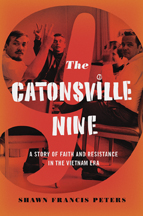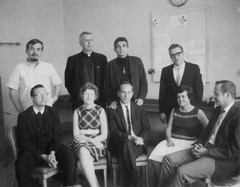The Burning of Paper Instead of Children

 Even as a kid, Shawn Peters was fascinated by the story of the Catonsville Nine, the first group of resisters to burn draft files during the Vietnam War. Growing up in Catonsville and schooled by conservative nuns who denounced the group, he learned how they awaited arrest for their action and used their trial to put the war itself on the stand. He reveled in their audacity, their creativity, and their courage as they faced trial, appeals, and imprisonment. Years and much detailed research later, he has given us an intriguing story, replete with lessons for resisters of today.
Even as a kid, Shawn Peters was fascinated by the story of the Catonsville Nine, the first group of resisters to burn draft files during the Vietnam War. Growing up in Catonsville and schooled by conservative nuns who denounced the group, he learned how they awaited arrest for their action and used their trial to put the war itself on the stand. He reveled in their audacity, their creativity, and their courage as they faced trial, appeals, and imprisonment. Years and much detailed research later, he has given us an intriguing story, replete with lessons for resisters of today.
What’s best about this book is the fact that it’s about all of the Nine, not just about the Berrigan brothers who received, and still receive, the lion’s share (cliché intended) of print and visual attention. For lions they were — big, craggy then-Father Phil, with his commanding personality and stalwart insistence that something could be done to make the war powers listen; Jesuit Father Dan, with his ebullient personality, poetic giftedness, and a charisma that continues to this day, even when he can no longer jump onto a stage or disappear into a puppet as he did when he was “on the lam” after sentencing for the draft board action. Phil Berrigan left the formal priesthood and went on to found Jonah House. There, with his wife Liz McAlister, he parented three children and the Plowshares antinuclear movement. Even in retirement, Fr. Dan still shepherds the peace movement. His play, The Trial of the Catonsville Nine, contains his line from the trial, “Our apologies, good friends, for the fracture of good order, the burning of paper instead of children.”
While these two are rightly remembered, Peters gives us clear pictures of each of the participants and successfully situates them in the political context of the times as he painstakingly details their lives and actions in the months surrounding the trial. We meet the gentle yet determined artist Tom Lewis, the unassuming John Hogan, and the mercurial Brother David Darst, tragically killed in a car accident before reporting for prison. Darst had publicly explained his rationale to WIN: “Something [had to] be done to stop the storm, to shake up this system of ours so that it has the chance to radically rearrange its values.”
TENACITY AND NEGLECT
We hear of the tenacity of George Mische as he recruited others to the movement. And how Tom and Marjorie Melville and John Hogan used the trial to publicize U.S. imperialism in Guatemala where they had worked with its victims. We learn of the complex Mary Moylan, a woman neglected by history, by the movement, and even, it seems, by the FBI.
Like the Melvilles and John Hogan, Moylan saw the imperialistic connections, in her case between the expensive war, the poor in Uganda where she had missioned, and the even more disenfranchised African-Americans in the DC neighborhood where she lived with the Misches after returning to the States. Friends remember her as lively and engaged during those times, with an obstinance that refused to back down. So it rends one’s heart to read of the changes wrought in her life after the trial and sentencing.
Like Phil and Dan Berrigan, Moylan also decided not to submit to imprisonment. She had become increasingly involved as a feminist since returning and wanted to show the world that women could also take this additional risk. Further, she resolved to seek support only from women, in solidarity with other women activists, not necessarily nonviolent. In her decision, she distanced herself from the Catholic Church and from the Catonsville group.
To avoid detection, she also dyed her beautiful red hair a murky black. Eluding a not-very-vigilant FBI, she lived hither and yon and sometimes awkwardly with her sisters in resistance. Finally in 1979, she turned herself in. After serving her time in Alderson Federal Prison, she went back to her nursing, but became increasingly reclusive and disturbed, finally dying in 1995, “‘poor, alone, and forgotten,’ according to Rosemary Reuther.” Her neglected story points out the sexism of U.S. culture as a whole, a sexism mirrored in the ultra-resistance of the Catholic Left.
 |
| Catonsville Nine at the police station, minutes after the action – Jean Walsh photo |
What of the lessons for activists from the Catonsville Nine and from this book in particular? What contrasts can we see between resistance then and resistance now? First the commonalities: A committed, skillful, and coordinated support community is just as important now as it was when the Catonsville Nine Defense Committee was writing press releases and Willa Bickham and Brendan Walsh of Viva House Catholic Worker were feeding hundreds of supporters every evening. The support group existed hand-to-mouth but was able to raise the money to publish several nationwide ads urging people to “come to Agnew Country,” proving that checkbook activism works. Support communities enthusiastically planned and attended rallies and vigils and trial- related protests in Maryland and throughout the country. They also provided as much support as was possible in the heavily guarded courtroom itself.
MUZZLED
These tactics still work in publicizing resistance trials, but defendants today are usually muzzled by judges forbidding defendants from using the prosecutor’s pre-trial list of forbidden terms—terms such as “first strike,” “Geneva Convention,” even the word “children.” In the Catonsville trial, the defendants were relatively more free and were fairly successful in discussing their motives and in putting the war itself on trial.
Thirdly, resistance breeds resistance. If people hear about it. People new to activism, with their cell phones and instant access to email and the internet may find it hard to understand how communicating only by phone and post worked. But it did. The late Sixties were a time when thousands of young people were on the move around the country, grouping and regrouping in amorphous configurations. The trial of the Catonsville Nine and the recruiting done by the group took advantage of this movement and served as an impetus to similar actions. It is estimated that upwards of 100 draft board raids followed on the Nine, culminating in the large Camden 58 action in 1972, with its dramatic trial and rare acquittal.
What is strikingly different about the Catonsville Nine and later resistance work is the lack of mainstream media attention. Civil disobedience today just doesn’t make news unless it’s violent. The media seems bored with trespass, petulant about property destruction, prosaic about prison terms. The rise of social media and alternative internet news sites means that news of resistance actions reaches mainly like-minded people, with correspondingly few avenues to increase their numbers. What non-violent actions can speak to the public as Catonsville did? I wish I knew.
The Catonsville Nine:
A Story of Faith and Resistance in the Vietnam Era
by Shawn Francis Peters
Oxford University Press.
416pp, $34.95
